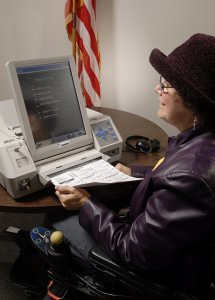One thing that has helped me quite a bit as a blogger, writer, grad student and person with chronic pain subject to flare-ups has been speech-to-text software. The basic idea is fairly self-evident: You install the software, plug in the headset that comes with it, open up the word processing program of your choice, and start talking.
Repetitive motion is one of those things that can be the bane of one’s existence if that person happens to have chronic pain issues; while there are people who might say, Oh, typing at a computer can’t be that painful or Just work through the pain or some other ridiculous piece of “advice,” typing can, at times, be enormously painful or draining for some folks with pain issues. No matter how much one may want to complete a piece, post or assignment, sometimes it just will not happen due to pain. When it feels like your hands are encased in cement blocks, there is no “working through the pain.” Having your hands and wrists feel like they have been set on fire by pain when you are on a deadline — like a lot of circumstances surrounding pain flares — can be excruciating. It’s kind of like having your hands and wrists feel like the Human Torch, but without any of the cool superpowers.
With speech-to-text, the additional pain brought on by repetitive typing is significantly reduced, as it takes at least some of the typing (but not editing, as I will address below) out of the equation. There are some additional issues to consider, however: one is “fibro fog,” the name given to some of the cognitive effects of a fibromyalgia flare, which can, for the person experiencing the flare, make it difficult to put thoughts, words and sentences together with anything resembling coherency. This is more of a condition issue than one that has to do with typing, but it’s fairly obvious as to how fibro-fog could impact the use of text-to-speech: if your thoughts are jumbled because of pain and fatigue, it’s likely that they will be just as jumbled regardless of whether you are typing or speaking into a text-to-speech headset. I’m fairly lucky with fibro-fog myself, as it tends to be rather mild unless I am experiencing a pain flare that feels closer to acute pain than chronic, but typing is one of those processes that can seem bizarrely confusing during a massive pain flare-up (and the whole “simple things as confusing” side effect is damn near impossible to truly understand unless you’ve been through it).
Of course, there are some aspects of text-to-speech software that are less than perfect: similar to the iPhone’s auto-correct feature (some of the amazing slip-ups of which have been documented by websites such as Damn You Autocorrect), speech-to-text software can “read” one spoken word or phrase as something else entirely, sometimes producing hilarious (or irritating) fragments that often make no sense within the context of what you are actually writing. My personal favorite thus far has been my speech-to-text program “translating” Judith Butler as Judas butt lark, which made me wonder if I need to work on my pronunciation skills if only for the convenience of my software program.
There is also the cost issue: many speech-to-text software programs are expensive. In a utopia, everyone who could benefit from text-to-speech programs would have a reliable and fairly-priced one ready for use. I’m one of those weirdos who thinks that accessible technology should not be something available only to those who can afford to pay for it, but that, unfortunately, is most likely a long time coming.

